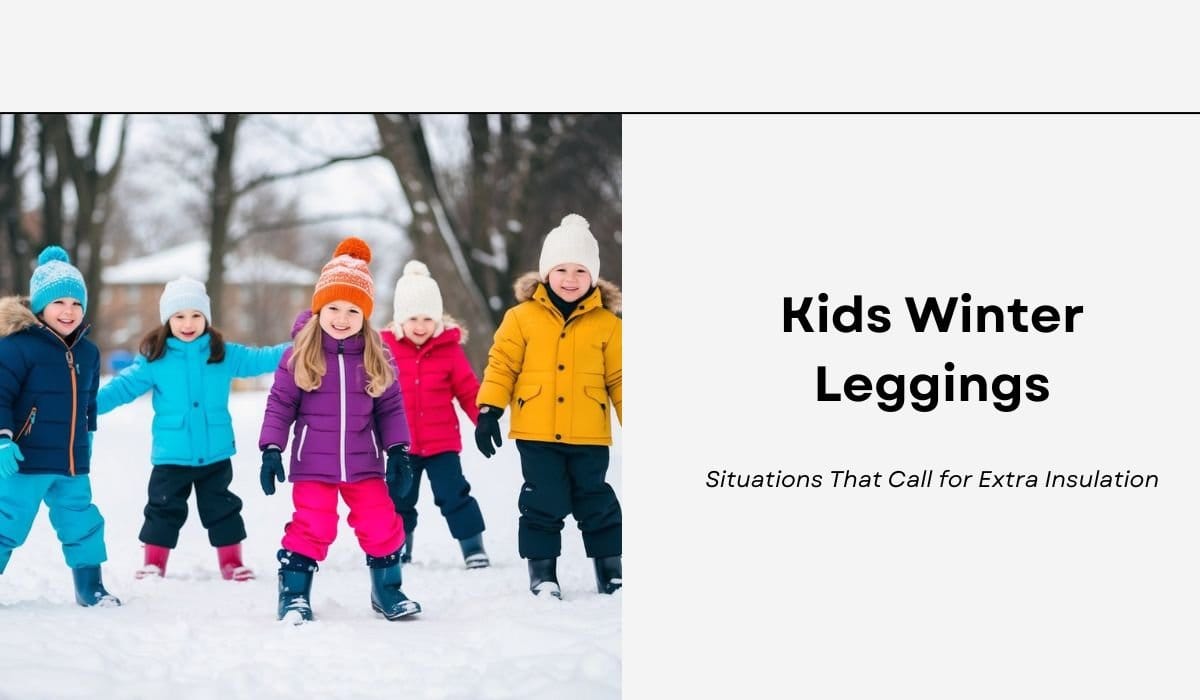Smart Layering for Every Winter Scenario: When Children Needs Extra Protection from the Cold
Winter can be a challenging time for parents trying to keep their children warm and cosy. Kids’ winter leggings are a crucial part of cold-weather dressing, providing essential insulation for little legs. Thermal leggings are ideal for outdoor activities, winter sports, and everyday wear in chilly conditions.
Layering is key to keeping kids comfortable in cold weather. Start with a base layer of thermal leggings, then add trousers or a skirt for extra warmth. For really cold days, consider pairing leggings with snow pants or ski trousers. This layering approach allows children to stay warm without feeling bulky or restricted in their movements.
When choosing winter leggings for kids, look for materials that offer good insulation and moisture-wicking properties. Merino wool and synthetic fabrics like polyester are popular choices. These materials help keep children warm and dry, even during active play in the snow or on the slopes.
On This Page
Key Takeaways
- Thermal leggings provide essential insulation for children in cold weather
- Layering with winter leggings helps kids stay warm without feeling bulky
- Choosing the right materials ensures warmth and comfort during winter activities
Understanding Insulation and Layering
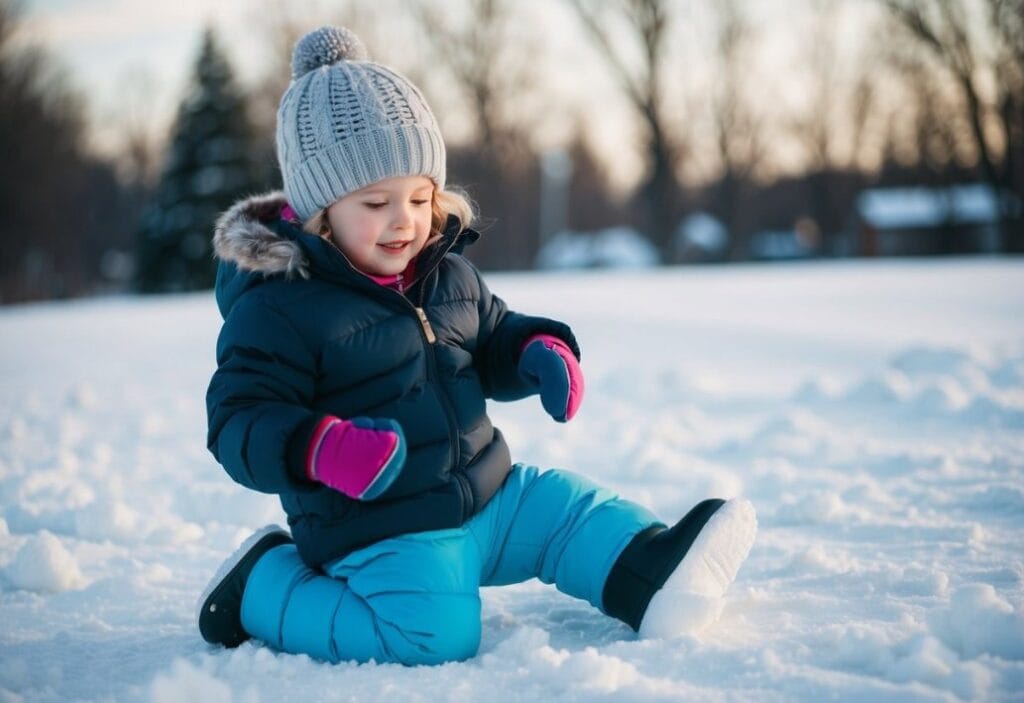
Proper insulation and layering are key to keeping kids warm in winter. These techniques help trap heat and manage moisture for maximum comfort.
Basics of Thermal Insulation
Thermal insulation works by trapping air between fibres. This slows heat loss from the body. Materials like wool, fleece, and down are great insulators.
For kids’ winter leggings, look for thick, fleece-lined options. These provide a cosy layer of warmth next to the skin.
Synthetic materials can also offer good insulation. They often dry quickly, which is handy for active children.
The Importance of Layering
Layering allows for better temperature control. It traps warm air between layers, creating insulation.
Start with a base layer that wicks moisture away from the skin. This keeps kids dry and warm. Merino wool or synthetic blends work well.
Add a mid-layer for extra warmth. Fleece or wool jumpers are good choices. They trap heat while allowing some airflow.
Top it off with a waterproof outer layer to protect from wind and rain. This helps keep the insulating layers dry and effective.
Layering lets you adjust for different activities and temperatures. Remove or add layers as needed to keep kids comfortable.
Choosing the Right Base Layer
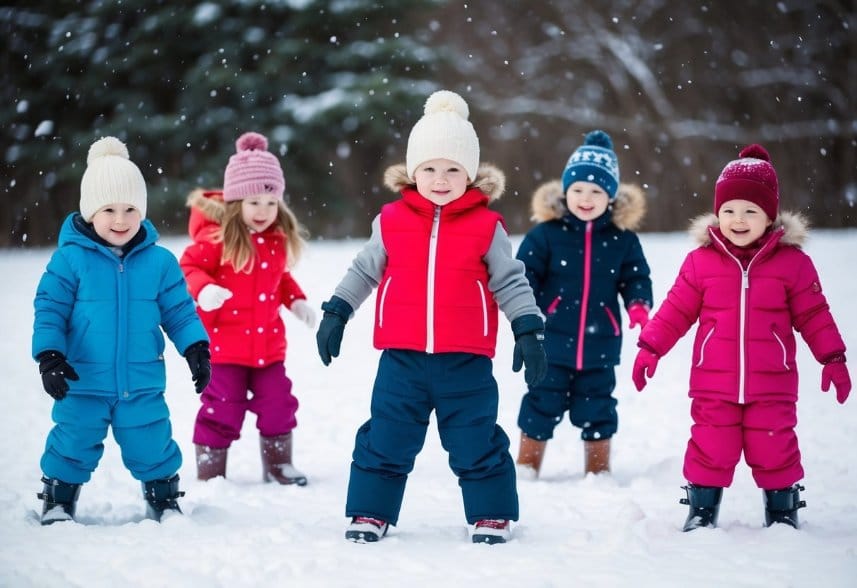
A good base layer is essential for keeping kids warm in winter. It forms the foundation of a child’s cold-weather outfit, providing insulation and moisture management.
The Role of Base Layers in Insulation
Base layers for kids act as a second skin. They trap warm air close to the body and wick away sweat. This helps regulate body temperature and keeps children dry. A snug fit is key for base layers to work properly. Loose layers can’t trap heat well.
Base layers come in different weights. Light layers work for mild days or active play. Medium-weight options suit colder conditions. Heavy base layers are best for very low temperatures.
Thermal socks are also important. They keep feet warm and dry inside winter boots. Look for socks made from wool or synthetic materials that wick moisture.
Merino Wool and Other Materials
Merino wool is a top choice for kids’ base layers. It’s soft, warm, and doesn’t itch. Merino wool can absorb up to 30% of its weight in moisture without feeling wet. It also fights odours naturally.
Other good materials include:
- Synthetic fabrics like polyester and nylon
- Silk (though less common for kids)
- Bamboo (eco-friendly option)
Synthetic materials dry quickly and are often cheaper than wool. But they may not control odours as well. Some brands mix wool and synthetics for the best of both worlds.
When picking a base layer, think about the child’s activity level and the weather. A good base layer will keep kids cosy all winter long.
Mid-Layer Selection for Extra Warmth
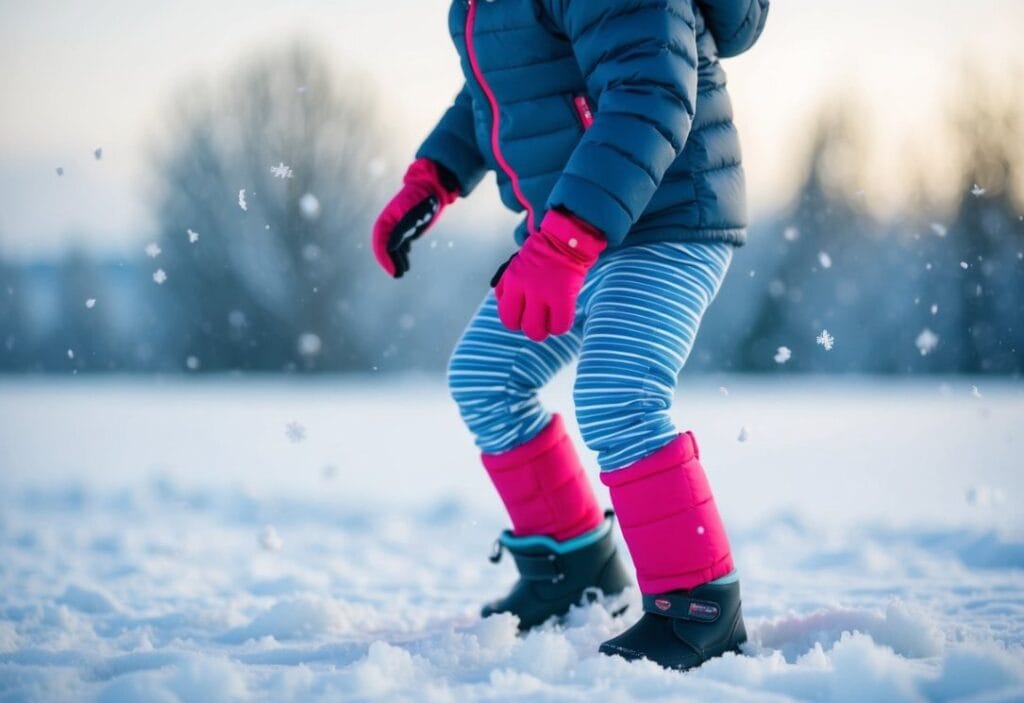
Choosing the right mid-layer is crucial for keeping kids warm in winter. The mid-layer traps heat while allowing moisture to escape, providing insulation between the base layer and outer shell.
Various Types of Mid-Layers
Fleece is a popular mid-layer option for children. It’s lightweight, quick-drying, and retains heat well. Fleece leggings are especially good for active kids. Wool is another excellent choice, offering warmth even when damp. Merino wool is soft and less itchy than traditional wool.
Down jackets or vests make great mid-layers in very cold conditions. They’re incredibly warm for their weight. Synthetic insulation is a good alternative for wet climates, as it retains heat even when wet.
Some brands now offer sustainable mid-layer options made from recycled materials. These eco-friendly choices perform just as well as traditional fabrics.
Balancing Warmth and Breathability
The ideal mid-layer strikes a balance between warmth and breathability. Too much insulation can cause overheating and sweating, leading to discomfort. Look for mid-layers with temperature ratings to match the conditions.
For active kids, choose breathable fabrics that wick moisture away from the skin. Zip-up mid-layers allow for easy temperature regulation. Layering thin, breathable pieces often works better than one thick layer.
Consider the child’s activity level when selecting a mid-layer. A thicker fleece might be perfect for sledging, while a lighter option suits playground play. Adjust layers as needed throughout the day to maintain comfort.
Outer Layer Considerations
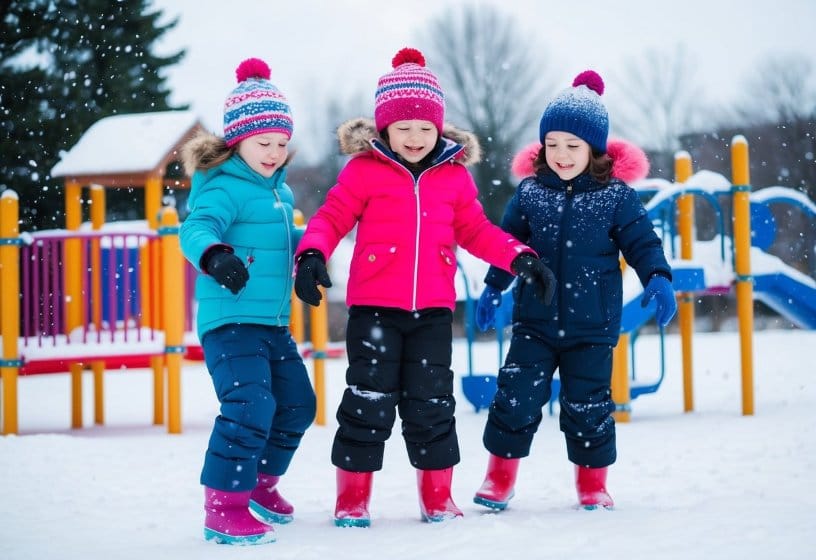
The outer layer protects kids from wind, rain and snow. It’s crucial for keeping children warm and dry during winter activities.
Water-Resistant and Protective Gear
Snow pants are a top choice for cold, snowy days. They’re waterproof and insulated to keep legs dry and toasty. Many have adjustable waists and cuffs to fit over boots.
For milder winter days, water-resistant joggers work well. They shed light moisture and block wind while allowing more movement than bulky snow pants.
Some kids prefer ski trousers. These offer similar protection to snow pants but with a slimmer fit. They often have extra features like built-in gaiters to keep snow out of boots.
Appropriate Choices for Kids’ Outerwear
A good winter coat is key. Look for waterproof, breathable fabrics with sealed seams. Insulation should be warm but not too bulky.
For active kids, a 3-in-1 jacket system is versatile. It has a waterproof shell and a removable fleece layer. This allows children to adjust for different weather and activities.
Snowsuits are great for toddlers and younger children. They keep the whole body warm and dry in one piece. This makes it easier to get little ones dressed for outdoor play.
Essential Winter Accessories for Kids
Keeping children warm and cosy in winter requires the right accessories. These items protect vulnerable areas like heads, hands, necks and legs from cold temperatures and winds.
The Necessity of Hats and Gloves
Hats and gloves are crucial for kids in cold weather. Warm hats prevent heat loss through the head and protect sensitive ears. Look for soft, lined hats that cover the ears fully. Knitted styles work well and come in fun colours kids enjoy.
Gloves shield little hands from icy winds. Waterproof gloves are ideal for snow play. For very young children, mittens may be easier to put on. Some gloves have handy clips to attach to coat sleeves so they don’t get lost.
For the coldest days, consider a balaclava-style hat that covers the head, ears and neck all at once. This extra coverage helps block out drafts and keeps kids snug.
Scarves and Leg Warmers
Scarves add warmth around the neck and can be pulled up to cover chilly cheeks. Choose soft fabrics that won’t irritate delicate skin. Tube-style neck warmers are a good option for active kids as they stay in place better than traditional scarves.
Leg warmers provide extra insulation under trousers or over leggings. They’re especially useful for keeping legs warm when wearing skirts or dresses. Leg warmers come in various lengths and can be pulled up over knees or bunched around ankles as needed.
For ultimate cosiness, pair leg warmers with thermal leggings underneath outer layers. This combination traps heat close to the skin and blocks out cold air effectively.
Selecting Leggings with Adequate Insulation
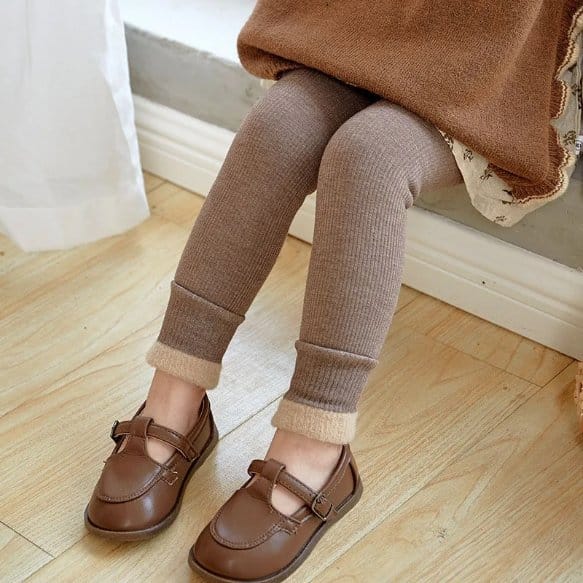
Kids winter leggings with proper insulation keep children warm in cold weather. The right features and materials make a big difference in comfort and protection.
Features of Insulated Leggings
Insulated leggings for kids often have a soft inner lining. This traps heat close to the body. Look for leggings made with thermal fabrics like polyester or nylon blends.
These materials wick away sweat to keep kids dry. Some leggings have extra layers for more warmth. Check the product details for the insulation level.
Elastic waistbands and cuffs help seal out cold air. Reinforced knees add durability for active children. Reflective details improve visibility in low light.
Fleece Leggings vs. Traditional Options
Fleece leggings offer excellent warmth for their weight. The fuzzy inner surface traps air for insulation. They’re soft, comfy, and good for lounging or light activity.
Traditional leggings may be thinner but work well for layering. They fit easily under snow pants or jeans. Some have a brushed interior for extra cosiness.
Fleece tends to be warmer but bulkier. Regular leggings are more versatile for different outfits. Both types come in various thicknesses for different temperatures.
Consider the child’s activity level and personal preference when choosing. Try both to see which style works best for your family’s needs.
Colour and Design Choices
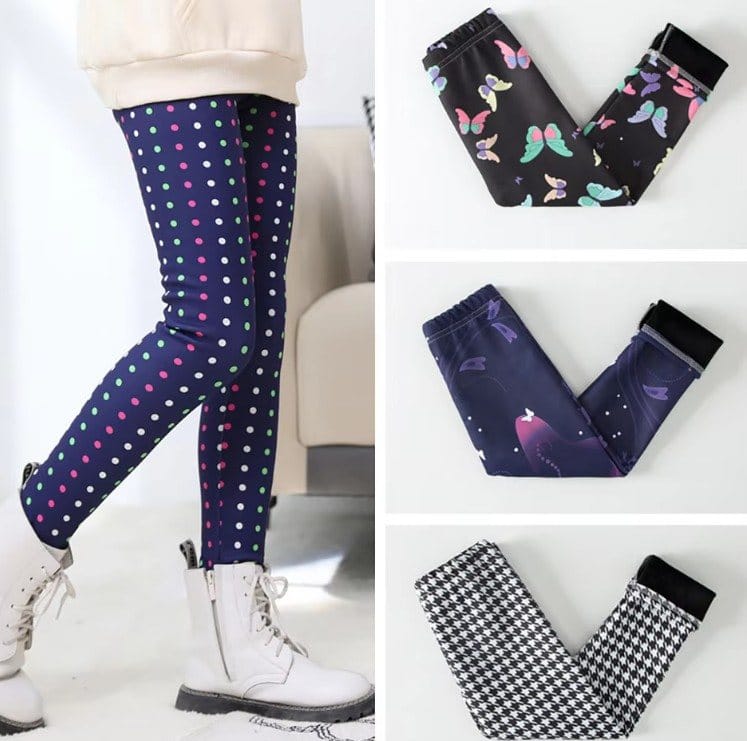
Kids’ winter leggings come in many colours and styles to suit different needs. The right choices can make leggings both practical and fun to wear.
Impact of Colours on Visibility and Style
Bright colours like neon yellow or orange boost visibility in low light. This is great for kids playing outside on gloomy winter days. Dark colours like navy or black hide dirt better, making them good for messy play. Pastels and neutrals are versatile for everyday wear.
Patterns add flair to winter leggings. Stripes, polka dots, and animal prints are popular. Some leggings have fun winter themes like snowflakes or penguins. Solid colours match easily with other clothes.
Integrating Functionality and Fashion
New kids’ winter leggings blend style with function. Some have reflective strips for safety. Others use special fabrics that wick sweat or block wind.
Many brands offer leggings with reinforced knees. This helps them last longer. Elastic waistbands make leggings comfy and easy to put on. Some styles have pockets for small items.
Fashion-forward leggings may have sparkles or metallic threads. Others use faux leather panels or mesh inserts. These details make basic leggings more exciting to wear.
Practical Tips for Dressing Children in Cold Weather
Keeping kids warm and comfy in winter requires smart clothing choices. The right layers and adjustments can make all the difference for outdoor play.
Layering Strategies for Kids
Start with a thin base layer made of wool or synthetic fabric to wick away sweat. Add a middle insulating layer like a fleece jumper or wool cardigan. Top it off with a waterproof, breathable outer layer.
For active kids, choose stretchy fabrics that allow movement. Thermal leggings work well under trousers or snow pants. Thick socks and insulated boots keep little feet toasty.
Don’t forget accessories. A warm hat, gloves, and neck warmer help lock in body heat. For babies, use a soft hat that covers the ears.
Adjusting to Changing Temperatures
Pay attention to your child’s activity level and the weather. Remove layers if they get too warm from running about. Add layers if the wind picks up or temperature drops.
Bring extra mittens and socks on outings. Little hands and feet often get wet from snow play. Pack a spare jumper too, in case the first gets damp from sweat.
For sledging or building snowmen, waterproof overalls are brilliant. They keep kids dry and block wind chill. Choose ones with adjustable cuffs to seal out snow.
On milder days, opt for a lighter coat with removable lining. This lets you adapt quickly as temps shift throughout the day.
Caring for Kids’ Winter Leggings and Accessories
Proper care keeps winter leggings and accessories warm and long-lasting. Regular maintenance and correct washing methods help preserve their insulating properties and appearance.
Maintenance and Durability
Check kids’ winter leggings and accessories for wear after each use. Look for small holes or loose threads. Fix minor issues quickly to prevent them from getting worse.
Brush off dirt and snow before it dries. This stops stains and fabric damage. For muddy boots or gloves, let them dry, then brush off the dirt.
Store items flat or hung up when not in use. Don’t cram them into drawers. This helps keep their shape and prevents creasing.
For sustainability, teach children to care for their clothes. Show them how to hang up coats and put away hats and gloves properly. This habit makes items last longer.
Washing and Dryings Recommendations
Always check care labels before washing. Most winter leggings can go in the washing machine. Use cold water and a gentle cycle.
Turn leggings inside out to protect the outer layer. Wash similar colours together to avoid dye transfer.
Use a mild detergent meant for delicates. Avoid fabric softeners, which can harm the insulating properties.
Air dry leggings when possible. If using a tumble dryer, use low heat. Remove promptly to prevent wrinkles.
For wool accessories, hand wash in cool water. Squeeze out excess water gently. Don’t wring or twist. Lay flat to dry away from direct heat.
Clean waterproof items with a damp cloth. If washing is needed, use a special cleaner for waterproof fabrics.
User Privacy and Online Shopping
Online shopping raises important privacy considerations. Customers should be aware of how their personal data is collected and used by e-commerce websites. Understanding privacy notices and the role of cookies can help shoppers make informed decisions.
Understanding Privacy Notices
Privacy notices explain how websites gather and use customer information. These notices outline what data is collected, why it’s needed, and how it’s protected. Key details include:
• Types of data collected (e.g. name, address, payment info) • How data is used (e.g. processing orders, marketing) • Third parties that may access the data • Customer rights regarding their information
Shoppers should read privacy notices before making purchases. This helps them decide if they’re comfortable with a site’s data practices. Clear, easy-to-read notices build trust between businesses and customers.
Importance of Cookies in E-Commerce
Cookies are small files stored on a user’s device when browsing websites. For online shopping, cookies serve several purposes:
• Remembering login details and preferences • Keeping items in the shopping basket • Providing personalised product recommendations • Tracking browsing history for targeted ads
While cookies enhance the shopping experience, they also raise privacy concerns. Some cookies track user behaviour across multiple sites. Shoppers can manage cookie settings in their browser preferences. Many e-commerce sites now offer cookie consent options, letting users choose which types to accept.
Frequently Asked Questions
Parents often have questions about choosing and using winter leggings for their children. These common queries cover warmth, materials, and versatility for different cold-weather situations.
What type of leggings are best for children during the colder months?
Thermal or fleece-lined leggings work well for cold weather. They provide extra insulation to keep kids warm. Look for moisture-wicking fabrics to keep children dry during activities.
How do fleece-lined leggings compare to regular leggings in terms of warmth?
Fleece-lined leggings offer more warmth than standard leggings. The soft inner lining traps heat close to the body. This makes them cosier for outdoor play in chilly weather.
Should thermal tights be worn under school uniforms in winter?
Thermal tights can be a good choice under school uniforms. They add warmth without bulk. Check school rules first, as some may have specific guidelines for winter wear.
What are the benefits of choosing grey thermal leggings for girls?
Grey thermal leggings are versatile and practical. They hide dirt well and match many outfits. The neutral colour works for both casual and dressier occasions.
Can fleece-lined tights be a suitable replacement for thermal leggings for kids?
Fleece-lined tights can replace thermal leggings in some cases. They offer similar warmth and fit easily under dresses or skirts. For very cold days, thermal leggings might provide more insulation.
What factors should be considered when purchasing winter leggings for outdoor activities?
When buying winter leggings for outdoor play, think about durability and weather resistance. Look for reinforced knees and water-repellent fabrics. Make sure they allow easy movement for active children.
Related Post: Insulated vs. Non-Insulated Leggings: Choosing the Right Pair for Your Workout

